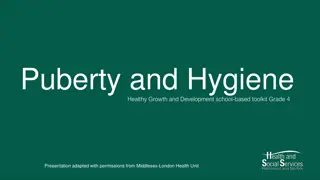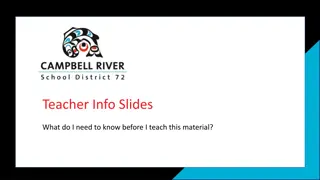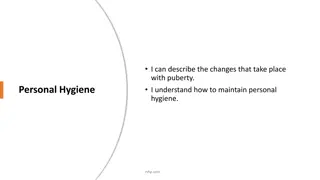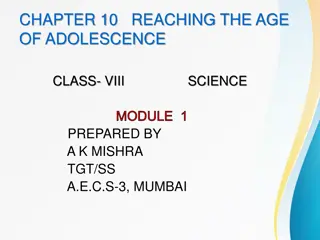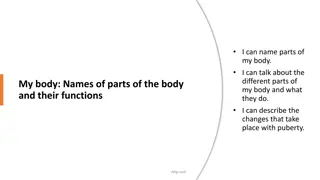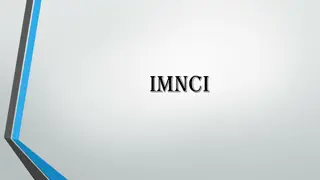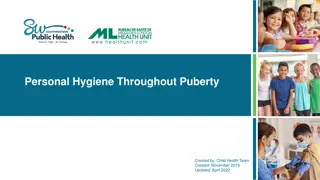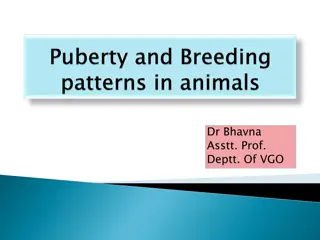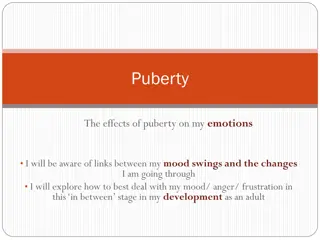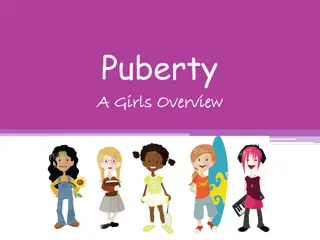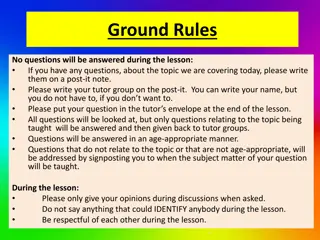Tips for Supporting Your Child Through Puberty Challenges
Parents of special-needs children face unique challenges when it comes to puberty. Prepare your child for changes, including menstruation, by starting early and teaching them about their body. Learn more about puberty preparation, menarche, and understanding the monthly cycle. Dr. Kavya Priya Vazrala, a gynecologist, offers helpful tips for giving your child a heads-up on puberty.
Download Presentation

Please find below an Image/Link to download the presentation.
The content on the website is provided AS IS for your information and personal use only. It may not be sold, licensed, or shared on other websites without obtaining consent from the author.If you encounter any issues during the download, it is possible that the publisher has removed the file from their server.
You are allowed to download the files provided on this website for personal or commercial use, subject to the condition that they are used lawfully. All files are the property of their respective owners.
The content on the website is provided AS IS for your information and personal use only. It may not be sold, licensed, or shared on other websites without obtaining consent from the author.
E N D
Presentation Transcript
Understanding Puberty for Female Bodies 7 To-Dos Support Challenges with menstruation & possible solutions for your special-needs child Puberty Preparing your child for changes.
Note from a Nayi Disha mother... Parents of a special-needs child often feel like their world has turned upside down during the difficult days of PMS & bleeding. Here are some things you can do ahead of time to prepare for the transition: Teach your child that they will grow & that s ok! Teach them that this is a normal aspect of having a female body! Like mummy! The more we prepare our children & ourselves for these changes & help them understand that they will be okay, the easier the transition into young adulthood! So what s a good way to teach your child about menstruation? Social stories.
Puberty Preparation Tips Dr. Kavya Priya Vazrala Gynaecologist HOW TO GIVE YOUR CHILD THE BEST HEADS-UP.
Understanding puberty 7 To-Dos Support What is puberty for the female body? Your child's body is going through changes. Some of these may be a challenge, give their special needs. The biggest changes that occur with puberty are: Body hair & odour, Breast development, Acne, Menarche i.e. first period, Monthly PMS symptoms like irritability & fatigue. Helping your child acknowledge & accept these changes is essential.
Understanding puberty 7 To-Dos Support When does it begin? Biology predetermines when menarche occurs. Menstruation starts later in children with developmental delays than in typical children. This usually happens between 10 & 14 years of age. The latest that menarche can occur is at 16 years of age. Due to recent hormone-mimicking pollutants in food, puberty may occur a few years earlier, among all children.
Understanding puberty 7 To-Dos Support The Monthly Cycle Each menstruator's cycle is different. Most cycles last 21-30 days, with a maximum of 40 days. On an average, bleeding lasts 1 - 7 days. Bleeding is heaviest on the first days & least heavy towards the end. It is normal to need to change pads 4-7 times on heavy-bleeding days. Regardless of flow, it is healthy to change pads every 5 hours. Remember, if during the cycle your child experiences extreme pain or excessive blood-clots, please consult your doctor.
Understanding puberty 7 To-Dos Support 7 To Dos #1 Start Early Help your child become familiar with their body from an early age. Teach them the names, positions, & functions of their private parts. Next, introduce the concept of privacy. Use everyday situations / social stories to explain the 2 Cs: Closing the door when going to the restroom or changing clothes. Covering private parts when in public.
Understanding puberty 7 To-Dos Support #2 Encourage Confidence Self-esteem & self-confidence are key to well-being. Every child with a disability or otherwise needs caregivers & adults around to help support their sense of self. Appreciate behaviour you want to see repeated. This will boost morale & encourage them to continue the behaviour. Allow them to voice their thoughts & opinions freely. Respect every child as an individual. This will introduce a sense of self-worth.
Understanding puberty 7 To-Dos Support #3 Grooming is Self-Expression Let your child see themselves in clothes, make up, hair styles that they prefer. This is crucial to a healthy self-image. Allowing them this freedom will preserve their self-esteem, boost their self-confidence, & encourage calm nerves.
Understanding puberty 7 To-Dos Support #4 Step Back a Little We can only be self-reliant when given the opportunity to practice picking up after ourselves. Let your child become independent by letting them: Clearly communicate their likes & dislikes early on. Do everyday activities on their own like brushing, bathing, etc. Clean themselves after using the facilities. Teach that it is important & normal to clean one's privates thoroughly, also during a bath.
Understanding puberty 7 To-Dos Support #5 Self-Protection Children with disabilities are most vulnerable to abuse of all kinds, whether girls or boys. Teach your child to be aware of their: Physical / Bodily Boundaries Explain that they don't need to compromise & be ok with all kinds of touch. Teach them to differentiate between safe touch & unsafe touch. Build trust & let them know they can & should approach you if someone makes them uncomfortable.
Understanding puberty 7 To-Dos Support #5 Self-Protection Emotional / Social Boundaries Abuse doesn't always involve touch. Exploitation may also be verbal or situational. Teach your child not to compromise in conversations / situations that make them uncomfortable. Use social stories to inform & protect them from being shown pornographic content, humiliation / being made to act out their disability, & being bullied some other way. The more aware your child is, the better they can look out for themselves. Be vigilant of the ways in which your non-verbal child may express their discomfort.
Understanding puberty 7 To-Dos Support #6 Visual Aides Use sequences of picture aids to explain to your child the steps to self-care & related words. For eg, build an association of the colour RED with blood. This will allow your child to recognise when they first begin bleeding. Normalize menstruation as any natural bodily function like needing food or sweating.
Understanding puberty 7 To-Dos Support #7 To Do for Heavy Bleeding Excessive bleeding during menstruation or menorrhagia may be caused by: TB infection of genital organs Condition of the blood platelets An under / over-active thyroid gland i.e. hypo / hyper-thyroidism
Understanding puberty 7 To-Dos Support #7 To Do for Heavy Bleeding Some non-medical ways of managing heavy bleeding & pain are: Maintaining a healthy weight & an exercise routine. Avoiding sugary &/ or salty foods. Eating balanced. First Resort Hydrating regularly. If bleeding is still heavy / pain persists, your gynec may suggest oral medication, to reduce cramps, bleeding, and/or mood swings. If this too is unsuccessful, introduce a hormonal intrauterine device (IUD) to the body. This is replaced every 5 years under local anaesthesia by a gynec. It acts as a contraceptive, reduces bleeding, and may even stop menstruation entirely. Next Resort Risk: Bleeding occurs in 30% women due to the insertion of a IUD.
Understanding puberty 7 To-Dos Support & parents are here to help! Nayi Disha s parent WhatsApp groups & monthly support groups are here for all your doubts regarding raising a special-needs child. To join the parent community &/or for more information, write to us: contactus@nayi-disha.org & visit www.nayi-disha.org for more resources on Menstrual care & health of your child.



